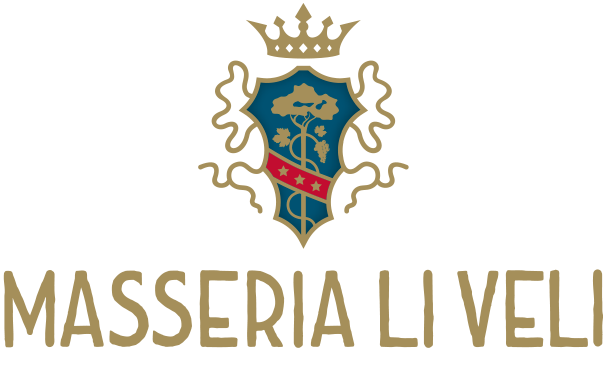Our Vineyards
The vineyards cover a total area of 58 hectares.
Of these, the most representative are those cultivated with the alberello system at high density planting, with 5120 plants per hectare with a settonce layout.
This pattern was invented by Roman military engineers who for a long time used the Latin square layout, later adopting the quinconce and finally the settonce, the ordo septuncialis.
The latter was also represented on a coin as a regular hexagon with six corners and a point in the centre.
Today the settonce layout with the alberello training system offers, more than any other system, an ideal combination of beneficial effects: maximum soil exploitation by the vine roots, maximum exposure of foliage to the sun, good circulation of air through the canopy, also in the central parts of the vineyards, and harmonious balance between the plants which all have the same space, both externally and below ground.
Veli Vineyard
Varieties
Primitivo, Negroamaro, Susumaniello, Aleatico, Verdeca
Layout
Spurred cordon
Alberello Settonce
Density
4.500
5.100
vines per hectare
Type of soil
clayey and sandy with calcareous traces
This plot, like the Masseria, owes its name to the historical district of which it is part and this is where the best grapes of the estate grow. Unique in the entire area, these soils combine a perfect balance between sand, loam and clay. An exceptional mixture allowing the vine to reach the perfect balance of growth and production which confers great elegance, minerality and freshness to the wines made from these grapes.
Veli Piccolo Vineyard
Varieties
Negroamaro
Layout
Spurred cordon
Density
4.500
vines per hectare
Type of soil
clayey and sandy with calcareous traces
This vineyard borders the Masseria at the foot of the Veli hillside. The soil here is of marine sediment, which gives it its typical grey colour, with a good percentage of sand. These vines produce wines of wonderful body and great structure and elegance.
Montecoco Vineyard
Varieties
Primitivo
Layout
Guyot
Density
4.500
vines per hectare
Type of soil
sandy, calcareous
A wonderful cru growing on Montecoco hill, from which the entire district takes its name. The calcareous soil reduces the amount of grapes produced but yields an exceptionally high quality product which well withstands a slight over-ripening of the bunch. The area benefits from the cool and windy conditions of the valley. The particular mineral composition enhances the characteristics of the grapes.
Pizzuti Vineyard
Varieties
Primitivo
Layout
Spurred cordon
Density
4.500
vines per hectare
Type of soil
clayey and sandy with calcareous traces
The southernmost vineyard, it is situated in an area particularly suitable for Primitivo which finds here its ideal habitat. The soil is composed of calcareous rock and clay, the latter slightly above average in quantity. The richness of minerals and the scarcity of organic elements allow the grapes to ripen perfectly. The wines produced from these grapes have good ageing potential.
Giovannella Vineyard
Varieties
Malvasia Nera, Negroamaro, Susumaniello, Primitivo
Layout
Spurred cordon
Density
4.500
5.100 vines per hectare
Type of soil
clayey and sandy with calcareous traces
The second largest vineyard of the estate, it includes many local varieties. The position, sheltered from the mistral winds of the Li Veli and Montecoco districts, influences the growth cycle of the vines. The soil here is deep, well-structured and particularly fertile. These characteristics allow the grapes to ripen in ideal conditions lending them structure and abundance of aroma.
Garrisa Vineyard
Varieties
Susumaniello, Primitivo
Layout
Spurred cordon
Density
4.500
vines per hectare
Type of soil
Sandy with calcareous traces
This small garden vineyard takes its name from the road marking its borders. The terrain is calcareous with a good percentage of sand, well aerated and quick to heat up leading to an early ripening of the grapes.




